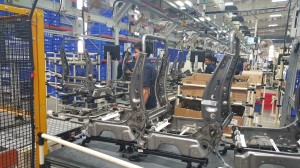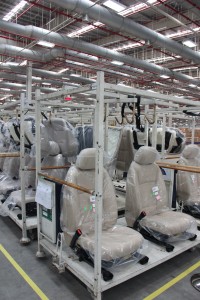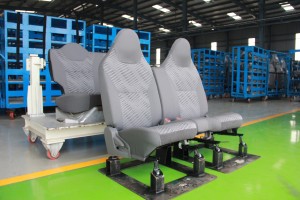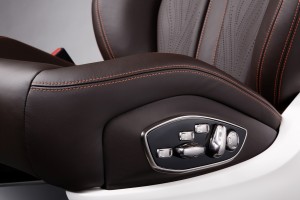Text : Bhushan Mhapralkar
Automotive seating systems have come a long way from the first car. They have become a crucial part of comfort, safety and ergonomic capability. The seating systems, spanning across automotives, from two-wheeler to a giant dump truck, have the participation of global giants like Lear Corporation, Faurecia, IFB Automotive, Magna, IAV, Dura Automotive, Aktis Engineering Solutions, Fisher and Company, Tata AutoComp Systems, Marter Automotive Seating Systems, Grammer Seating Systems and others.
Seatings systems are becoming not just intelligent but innovative. They are being subjected to numerous light-weighting experiments. Expected to grow at a CAGR of 5.18% between 2015 and 2020, the global automotive seating systems market is projected to grow from $ 28,545.6 million in 2015 to $36,752.4 million by 2020. Segmented on the basis of vehicle type, technology, seat type, cover material, and region, automotive seating systems are changing a lot. As OEMs strive to enhance the efficiency of the vehicles they are developing, their demand is for seats that are lighter and better.
Market vibes
The US market amounts to 58% of the automotive systems market. It is also the most advanced seating systems market. Europe, at 30% is no less advanced or innovative in terms of the development and manufacture of seating systems. The Asian countries like China, Japan, India, and South Korea, account for the rest. Made up of the Tier 1 companies that produce complete seats, and Tier 2 companies that supply seating system components, including textile companies or leather manufactuers, which supply seating fabrics and covers, the automotive seating systems market is seeing opportunities and challenges as customers demand luxury.
Referred to as expensive and heaviest interior parts, seating systems, segmented on the basis of seat type (split seat, bench seat or a split bench seat), should be structurally robust, vibration and noise absorbent. Segmented on the basis of vehicle type as well (passenger vehicle seat or commercial vehicle seat), and differentiated on the basis of their distribution channel (consumed by an OEM or the aftermarket), automotive systems should protect the occupant in the event of a crash. Not to forget, they have to be light in weight as well.
Cost and weight reduction
Apart from lighter and better seats, seating system manufacturers are also forced to cut cost. They, therefore, are experimenting with new and different designs and materials. Often judged subjectively by a vehicle occupant and the driver as to how comfortable or supportive they are during long distance travel, or over a variety of road surfaces, automotive seats, are subject to much scrutiny irrespective of their presence in a budget runabout, an economy segment motorcycle, or in a luxury bus. Rapid urbanisation increases the number of automotives globally and vehicle occupants spend more and more time in their vehicles. For the commercial vehicles, seating systems are very important as operators of buses and trucks have to travel long distances. In the US and Europe, long distance travel even in cars is common. A similar pattern is taking shape in emerging automotive markets like India.
Rising average speed of travel, owing to better roads, demands that seats also contribute to safety. Seating systems are thus coming to be looked upon as protective gears in case of a collision. Whatever may be the impact, the seat and its associated technologies like headrests, seat belts, air bags etc. should protect the occupant, as much as possible, from any impact.
Safety and luxury
The task of combining safety and luxury in a vast variety of vehicles makes the designing of a seat challenging. Offering the driver unhindered vision and unfettered access to all control mechanisms, and accommodating all shapes and sizes of bodies in comfort, an automobile seating system should not fail in areas like frame, anchorage, adjustment and displacement or the locking devices.
Subjected to Finite Element Analysis (FEA), Computational Fluid Dynamics (CFD), Kinematic Analysis of Mechanisms and Tolerance Stack-Up Analysis to arrive at a sound design that is safe, flexible and comfortable, it is also essential that a seating system is lightweight, smart, and compliant with safety norms. Electronics is finding a way into seating systems to address better the above-mentioned demands. A host of seat adjustments are today done by simply operating a toggle switch on the seat side – for fore and apt movement; for adjusting the seat height; for adjusting the reclining angle; for lumbar support, and even the adjustment of head rests. The pneumatically suspended driver’s seat of a truck has come to be electronically adjusted. A pneumatic seat systems developed by Continental claims to offer clear technical advantages besides comfort.
Technology
The Continental pneumatic seat system has a multi-contour seat function, which allows vehicle occupants to adapt the contour of the seat to their individual requirements. Via air cells integrated into the backrest and seat cushion the seat adjusts to fit the body. An optional massage function further enhances comfort for vehicle occupants on long journeys by means of alternate inflation and deflation of the air cells.
The drive dynamic function automatically adapts the side bolsters of the seat to the current driving situation, ensuring optimum stability for occupants at all times, and even when cornering. Compared with electromechanical systems, pneumatic seat systems, according to Continental sources, operate more quietly and weigh significantly less. They also allow more precise adaptation to the body shape and can withstand greater mechanical stress. Made up of a seating frame and components, foams, cushion and back rest, and seat adjustment and reclining mechanism, seating systems are starting to get truly innovative.
Faurecia’s Active Wellness detects traveler drowsiness or stress and takes countermeasures. The seat employs uniquely designed sensors to measure heartbeat, breathing rhythm of drivers and/or occupants and other data based on the most recent medical research. It then provides a very specific massage pattern, along with air flow through the seat’s ventilation system, either to re-energise a tired occupant or to relax a stressed individual, making life on board a more healthy.
Thinner, more robust seats
The mid-market cars favoured by a large section of consumers are coming with thinner seats with integrated head rest. Apart from saving weight, slim seats like these enhance the visual comfort and roominess of the cabin. Rear seat legroom is especially enhanced in automobiles that are likely to feel the need. To support slim seats, Faurecia developed a slim backrest from cover carving technology that reduces the amount of foam required. Curved side members with a sculpted light panel provide more knee room for second-row passengers. A lower cross member and recliner and a more forward-positioned rear tube also provide more legroom. Fauercia also chose to use a hybrid generic frame inside. It is designed to be fully compatible with Faurecia’s generic process already in place on a large scale across the globe, and maintains all safety and comfort requirements.
Intelligent seats and headrests
Active headrests are intelligent headrests according to an industry expert. Found on BMW 5 Series, they minimise the backwards movement of the head and reduce the risk of neck or head injury. Sensors immediately recognise an impact situation. A pressurised gas generator is triggered, moving the headrests forward to gently support the head. The vertebrae and muscles of the neck are protected from the strain and trauma that can result from an accident. The adaptive ‘Dualmotion’ back seat support system for construction machine seats Grammer AG displayed at the Bauma Fair is aimed at wheel loaders and rollers.
The operator often needs to twist around to keep an eye on the danger zone at the rear. They are also buffeted by vibrations and jolts when traveling on uneven and sloping terrain. These factors increase the risk of back pain and injuries. The upper backrest section fully automatically adapts to the driver’s posture when twisting around to face toward the rear. ACI














Leave a Reply